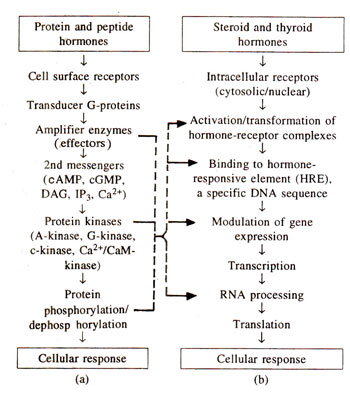
Fig. 37.22. Different steps involved in 'signal transaction pathways' for regulation of gene expression due to action of (a) protein/peptide hormones; (b) steroid and thyroid hormones (also note cross-linking between two pathways).
In animals as well as in plants, the cellular machinery for protein synthesis responds to external stimuli. These external stimuli may include a whole range of diverse factors including the following : (i) the presence of hormones, growth factors and other signalling molecules (e.g. in animals); (ii) the presence of
pheromones secreted by cells of two different mating types (i.e. in yeast); (iii) presence of light (different wave lengths), gravity, minerals, water, gases and specific soil structure (e.g. in plants) and (iv) cell-cell contact. In some of these cases,
cell surface receptor molecules are present and transmit the signal to the interior of the cell (for water-soluble signals like proteins, peptides and neurotransmitters). In other cases, substances like hormones interact with
intracellular receptors, which transmit the signal further to the target site (for water insoluble lipophilic signals like steroids, thyroid hormones, retinoic acid, etc.). In all these cases (including prokaryotes), the external stimulus needs to be transduced and integrated with internal signals, which follow a cascade of events called-
'signal transduction pathway' -leading to the response, which is a specific gene expression in many cases (Fig. 37.22).

Fig. 37.22. Different steps involved in 'signal transaction pathways' for regulation of gene expression due to action of (a) protein/peptide hormones; (b) steroid and thyroid hormones (also note cross-linking between two pathways).
Signal transduction pathways precede most of the mechanisms for regulation of gene expression discussed earlier. In prokaryotes, often the precursor molecule (e.g. lactose) or the end product (e.g. an amino acid) of a biosynthetic pathway takes part in regulation of gene activity. But in 'signal transduction pathways' in eukaryotes a cascade of molecules, leading to the activation of one or more specific transcription factors, is involved in regulation of gene activity.
The extracellular
'signals' in the form of ligands, are transduced across the plasma membrane to cell compartments (nucleus and other cells organelles) via a variety of molecules described as
'second messengers'. The
'effectors' i.e. molecules which bind to specific receptors to initiate the pathways for the production of
'second messengers', are often described as
'first messengers'. The binding of this effector to receptor is often- mediated by a protein, whose activity depends on GTP/GDP binding. These GTP/GDP binding proteins are called
G-proteins (see
Genetics of Cancer : Proto-oncogenes, Oncogenes and Tumour Suppressor Genes). There is also another set of cytosolic effectors, through which 'second messengers' produce a wide variety of cellular responses. Although there are millions of molecules which send signals into the cell interior, only half a dozen or so 'second messengers' have so far been identified (e.g. cAMP, cGMP, DAG, IP
3, Ca
2+, etc.). Actually, signal transduction pathways are also known, which do not involve any 'second messenger' molecules (e.g. response to interferon
a, insulin, steroid and thyroid hormones, etc.).






